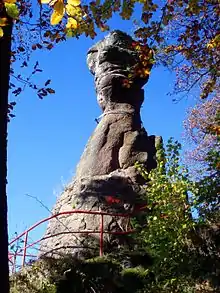
The Gänseschnabel (a porphyritic rock), ca. 1900[1]

The Gänseschnabel

View of the Behre valley
The Gänseschnabel is a natural monument north of Ilfeld in Thuringia, Germany. It is a striking, free-standing rock pillar made of porphyry, which resembles the beak of a goose (or duck) and from which there is a comprehensive view of the Behre valley looking towards Netzkater.
There is a legend connected with the Gänseschnabel about a spellbound goose girl who had fallen in love with a monk from the monastery at Ilfeld. A witch went to transform the monk in a rock when he waved to her from the other side of the valley. As the goose girl burst into tears, the witch turned her to stone as well.
References
- ↑ Coloured black-and-white photograph.
Sources
- Graevert, Horst (1984), Meyenburg Museum (ed.), "Der Gänseschnabel", Beiträge zur Heimatkunde aus Stadt und Kreis Nordhausen (in German), Nordhausen, vol. Heft 9, pp. 22–25
51°35′7.98″N 10°47′32.69″E / 51.5855500°N 10.7924139°E
This article is issued from Wikipedia. The text is licensed under Creative Commons - Attribution - Sharealike. Additional terms may apply for the media files.